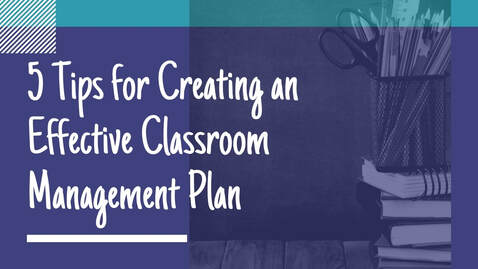5 Tips for Creating an Effective
Classroom Management Plan
Managing a classroom of 30 students is no small feat. Sometimes it can feel just plain stressful.
How do you handle behavior issues? How can you run your classroom smoothly and efficiently?
Instead of focusing on how to put out fires, I started focusing on how to prevent them in the first place.
If you think for a second, it’s just like health issues. You can go to the doctor and get a prescription that will help you deal with the problem. Or you can go to a doctor who will help you treat the cause to stop the problem all together.
Too often I think teachers are focused on the medicine, or fixing a problem. But if they took the time to focus on prevention, then a whole new world of possibilities open up.
So the question becomes, How can you be preventative with classroom management?
How do you handle behavior issues? How can you run your classroom smoothly and efficiently?
Instead of focusing on how to put out fires, I started focusing on how to prevent them in the first place.
If you think for a second, it’s just like health issues. You can go to the doctor and get a prescription that will help you deal with the problem. Or you can go to a doctor who will help you treat the cause to stop the problem all together.
Too often I think teachers are focused on the medicine, or fixing a problem. But if they took the time to focus on prevention, then a whole new world of possibilities open up.
So the question becomes, How can you be preventative with classroom management?
I have discovered the answer to that question is to provide STRUCTURE and that structure comes in two ways:
#1 - A Sold, Thorough Classroom Management Plan
#2 - Fair, Consistent Execution of a Discipline Plan
In this post, you are going to learn the difference between these two structures and 5 tips for creating your own classroom management plan.
What's the Difference
Yes, a classroom management plan and a discipline plan are two separate things.
A discipline plan is made up of 3-5 effective classroom rules, the consequences for breaking those rules, and rewards for following those rules well.
A classroom management plan is made up of numerous practices and procedures you teach your kids about how to be students in your classroom. But the trick is you have to TEACH these procedures. Show, model, practice, and reinforce.
Your discipline plan, or classroom rules and consequences are your non-negotiables. As the teacher, you are in charge. You must set the rules and consequences.
Some teaching philosophies suggest having the students help make the rules promotes by-in and compliance. While this may be true for primary grades, students of grades 3 and up will prosper more from clear guidance. And if you are teaching primary and struggling with classroom behaviors, then you may need to set your own rules and consequences too.
Your classroom management plan has room for change and flexibility. The whole purpose is to help your classroom run smoothly. If a procedure is not working, then you need to change it. This is where collaboration with your students comes in. Problem solving together can have many benefits. If you find a routine isn’t working for you, then talk about it with your students. It’s the perfect opportunity for them to learn how to make changes for the better.
A discipline plan is made up of 3-5 effective classroom rules, the consequences for breaking those rules, and rewards for following those rules well.
A classroom management plan is made up of numerous practices and procedures you teach your kids about how to be students in your classroom. But the trick is you have to TEACH these procedures. Show, model, practice, and reinforce.
Your discipline plan, or classroom rules and consequences are your non-negotiables. As the teacher, you are in charge. You must set the rules and consequences.
Some teaching philosophies suggest having the students help make the rules promotes by-in and compliance. While this may be true for primary grades, students of grades 3 and up will prosper more from clear guidance. And if you are teaching primary and struggling with classroom behaviors, then you may need to set your own rules and consequences too.
Your classroom management plan has room for change and flexibility. The whole purpose is to help your classroom run smoothly. If a procedure is not working, then you need to change it. This is where collaboration with your students comes in. Problem solving together can have many benefits. If you find a routine isn’t working for you, then talk about it with your students. It’s the perfect opportunity for them to learn how to make changes for the better.
5 Tips to Create Your Management Plan
#1 Determine Your Non-Negotiables
What is essential to you being able to teach and your students being able to learn?
This is what you must ask yourself when you start this process. Anything that is essential, should be included with your Discipline Plan.
#2 Teach Your Procedures
The biggest mistake teachers make, is not taking the time to teach their procedures. Use visuals, explanations, and practice to teach your procedures just like you would any other skill.
If you find students are not meeting your expectation, then it’s time to revisit the procedure. We all need reminders and sometimes a little more practice.
The start of a new quarter or semester is the perfect opportunity to revisit procedures and evaluate what’s working and what needs adjusting. But if you know there’s a problem, don’t wait to fix it. The problem will only get worse.
#3 Utilize Every Minute of Class Time
Pay close attention to the first 10 minutes of class and the last 10 minutes of class. I have heard from several administrators that this is where they see the most time wasted during observations.
Having procedures for how students enter your classroom and prepare for the lesson can help you get your instruction started on time.
Always have a few activities in your back pocket in case your lesson ends early. Teaching a new study strategy is always a good time filler.
#4 Anticipate Behaviors and Be Proactive
It’s always easier to be proactive instead of reactive. When planning lessons, it’s always helpful to play the movie in your mind.
What will you ask students to do? How will they do it? How and when will they get the supplies they need?
If an issue arises that you didn’t foresee, be sure to learn from it and have a plan in place next time.
#5 Be Firm, Fair, and Consistent
Your students will take notice if you enforce the rules sometimes and not others. They will probably notice quicker than you do. Of course there may be extenuating circumstances, but if this happens and it’s not addressed, then you will have lost your students.
It’s also important that you are compassionate and understanding with your students. This doesn’t mean you bend the rules for them – it just means you help them manage special situations. I am always willing to work with a student, if they are also willing to make an effort and do their part.
What is essential to you being able to teach and your students being able to learn?
This is what you must ask yourself when you start this process. Anything that is essential, should be included with your Discipline Plan.
#2 Teach Your Procedures
The biggest mistake teachers make, is not taking the time to teach their procedures. Use visuals, explanations, and practice to teach your procedures just like you would any other skill.
If you find students are not meeting your expectation, then it’s time to revisit the procedure. We all need reminders and sometimes a little more practice.
The start of a new quarter or semester is the perfect opportunity to revisit procedures and evaluate what’s working and what needs adjusting. But if you know there’s a problem, don’t wait to fix it. The problem will only get worse.
#3 Utilize Every Minute of Class Time
Pay close attention to the first 10 minutes of class and the last 10 minutes of class. I have heard from several administrators that this is where they see the most time wasted during observations.
Having procedures for how students enter your classroom and prepare for the lesson can help you get your instruction started on time.
Always have a few activities in your back pocket in case your lesson ends early. Teaching a new study strategy is always a good time filler.
#4 Anticipate Behaviors and Be Proactive
It’s always easier to be proactive instead of reactive. When planning lessons, it’s always helpful to play the movie in your mind.
What will you ask students to do? How will they do it? How and when will they get the supplies they need?
If an issue arises that you didn’t foresee, be sure to learn from it and have a plan in place next time.
#5 Be Firm, Fair, and Consistent
Your students will take notice if you enforce the rules sometimes and not others. They will probably notice quicker than you do. Of course there may be extenuating circumstances, but if this happens and it’s not addressed, then you will have lost your students.
It’s also important that you are compassionate and understanding with your students. This doesn’t mean you bend the rules for them – it just means you help them manage special situations. I am always willing to work with a student, if they are also willing to make an effort and do their part.
Ready to Roll Materials
A solid classroom management plan is the backbone of good instruction. Without it, you will be more likely to struggle as a teacher.
When you sit down to create your classroom management plan, be sure to keep the 5 tips from this post in mind. But, if you are looking for more guidance, then take a look at my exact Classroom Management Plan. You can use it as a guide in creating your own.
When you sit down to create your classroom management plan, be sure to keep the 5 tips from this post in mind. But, if you are looking for more guidance, then take a look at my exact Classroom Management Plan. You can use it as a guide in creating your own.
You Might Also Like...
Let's Connect...

Welcome! I'm Hillary Midgley, a veteran 6th grade teacher.
I create educational materials and develop curriculum for other teachers. I specialize in teaching students how to learn through my Study Skills Curriculum. I have established fundamental classroom systems and structures for teachers to help them streamline their classroom. And my passion is teaching ancient history through engaging activities with foundations in academic skills. Here you will find resources on all of these topics and more. Learn more about me here.
|






